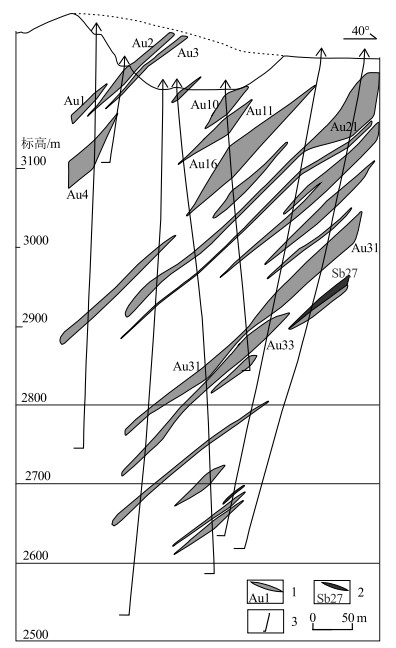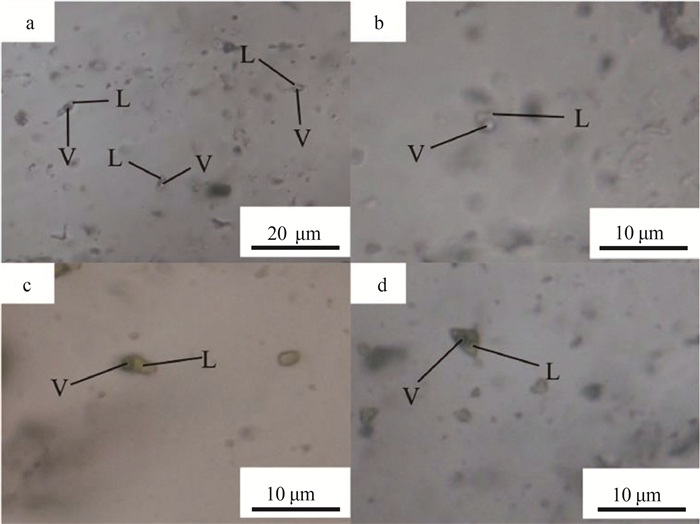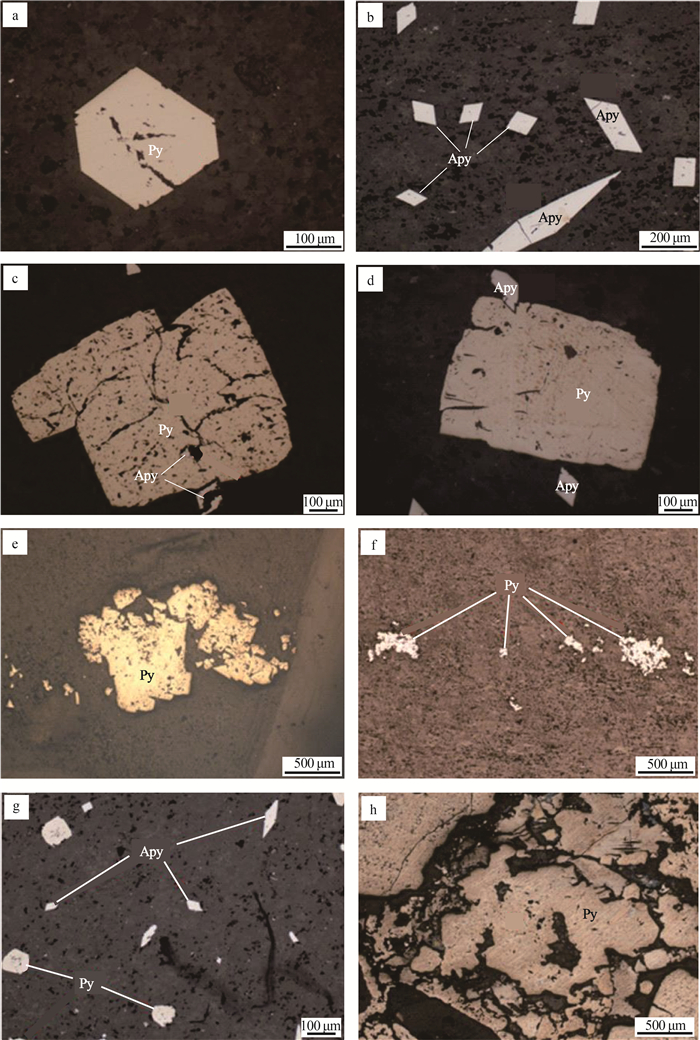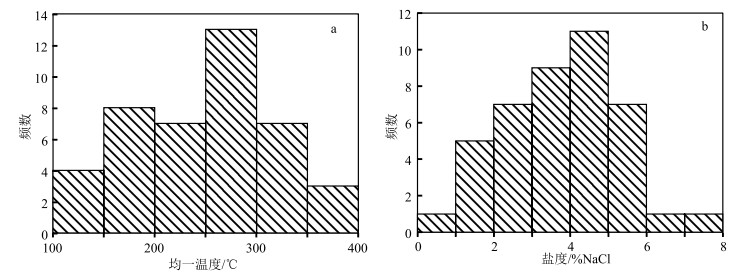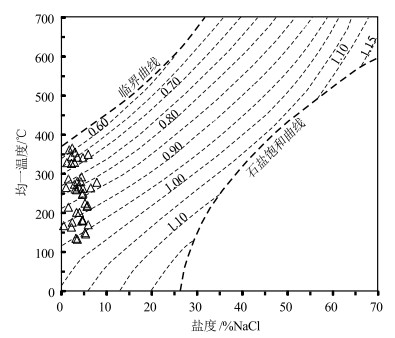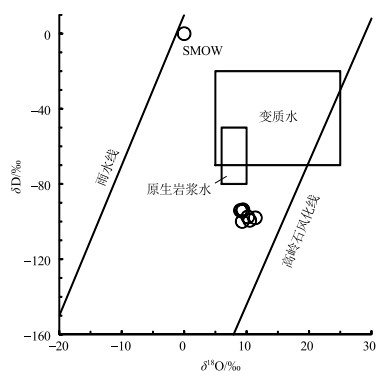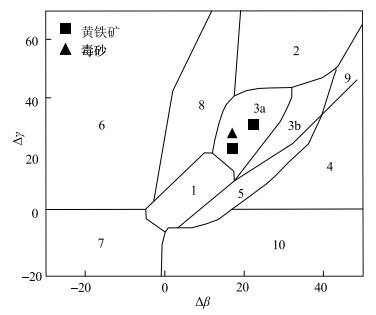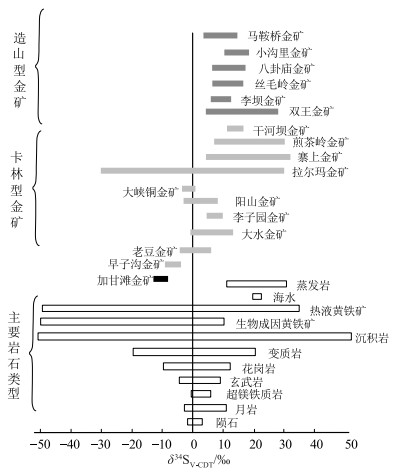Fluid inclusions and H-O-S-Pb isotopic characteristics of the Jiagantan gold deposit in Gannan, West Qinling
-
摘要:
加甘滩金矿床是西秦岭甘肃省甘南藏族自治州夏河-合作矿集区近年发现的资源量最大的金矿床。金矿体赋存在中上三叠统细碎屑岩中, 矿体的产出受NW向逆冲断裂及其次级构造控制, 呈雁行状、羽状分布, 矿体形态为板状、脉状、分叉状。矿床热液期主成矿阶段矿物组合为石英-黄铁矿-毒砂-辉锑矿-自然金。为进一步查明矿床成矿物质来源, 分析矿床成因, 本次在矿床地质调查的基础上, 开展了系统的流体包裹体、氢-氧-硫-铅稳定同位素测试分析。加甘滩金矿主成矿阶段石英包裹体类型为气液两相包裹体, 其中, 富液相两相包裹体最为常见。成矿流体均一温度均值为248.67℃, 盐度均值为3.78‰ NaCl, 具有中低温、低盐度的特征; 石英δ18OH2O值为10.42‰~13.82‰, δD值为-101.2‰~-93.2‰, 成矿流体组成较复杂, 可能既有岩浆水, 也有变质水的参与。主成矿阶段黄铁矿和毒砂δ34S值为-13.4‰~-7.5‰, 可能来源于岩浆作用或变质沉积地层; 铅同位素组成相似, 主要来源于造山带铅, 有部分上地壳铅和地幔铅加入。加甘滩金矿床成因类型为与岩浆有关的金矿床, 它的形成与印支期洋壳俯冲产生的深部岩浆作用密切相关。
Abstract:Jiagantan gold deposit is the largest gold deposit discovered in Xiahe-Hezuo area of West Qinling in recent years. The gold ore bodies occur in the fine clastic rocks of the Middle and Upper Triassic. The gold ore body occurs in the Middle and Upper Triassic fine clastic rocks. The occurrence of the ore bodies is strictly controlled by the NW thrust faults and its secondary structure, and they are distributed in echelon and pinnate forms, and the ore bodies are in vein, plate and bifurcated forms. Main mineral assemblages in the main ore-forming stage of the hydrothermal stage are quartz-pyrite -arsenite -stibnite -natural gold. In order to identify the source of ore forming materials and analyze the genesis of the deposit, a systematic fluid inclusion and H-O-S-Pb stable isotopic testing analysis was conducted based on the geological survey of the deposit. The quartz inclusion type in the main mineralization stage of the Jiagantan gold deposit is gas-liquid two-phase inclusion, and liquid-rich two-phase inclusions are the most common. The average temperature of ore-forming fluid is 248.67℃, and the average salinity is 3.78% NaCl, which is characterized by low temperature and low salinity. On the δD - δ18OH2O diagram, the samples are close to the primary water range of the primary magma and mantle. The δ34S value of sulfide (-13.4‰~-7.5‰) is characterized by obvious negative value and narrow range of variation. The Pb isotopic compositions of pyrite and arsenopyrite are similar. The lead is mainly from orogenic belt, and some of the lead from upper crust and mantle is added. The genetic type of the Jiagantan gold deposit is a wide-range low-temperature hydrothermal gold deposit far away from the ore-forming geological bodies. Its formation is closely related to the deep magmatism produced by the subduction of the oceanic crust in the Indosinian period.
-

-
图 5 加甘滩金矿流体包裹体均一温度-盐度- 密度(Ahmad,1980)
Figure 5.
图 6 不同类型水的δ18O-δD图解(据杨学明等,2000)
Figure 6.
图 7 铅同位素构造模式图和构造环境判别图(Zartman et al., 1981;A、B、C、D为各区域中样品相对集中区)
Figure 7.
图 8 铅同位素△β-△γ成因分类图解(朱炳泉,1998)
Figure 8.
图 9 加甘滩金矿与西秦岭地区典型金矿床、主要岩石类型硫同位素分布对比图(底图据靳晓野,2013)
Figure 9.
表 1 加甘滩金矿矿石中石英流体包裹体均一温度、冰点与盐度
Table 1. Homogenization temperature, freezing point and salinity of Jiagantan gold deposit
序号 矿物 包体类型 大小/ μm 气液比 均一温度/℃ 冰点温度/℃ 盐度/%NaCl 1 石英 V+L 6×6 20 329.3 -1.7 2.90 2 石英 V+L 9×6 35 342.5 -2.1 3.54 3 石英 V+L 5×4 10 262.7 -2.9 4.78 4 石英 V+L 8×3 25 361.5 -1 1.74 5 石英 V+L 8×2 12 279.8 -2.1 3.54 6 石英 V+L 6×3 20 340.9 -2.9 4.78 7 石英 V+L 8×5 8 214.7 -0.9 1.57 8 石英 V+L 6×4 28 355.2 -1.8 3.06 9 石英 V+L 8×4 8 224.9 -3.2 5.23 10 石英 V+L 9× 8 8 163.7 -1.3 2.24 11 石英 V+L 16×12 5 173.6 -2.4 4.01 12 石英 V+L 10×6 10 181.7 -2.8 4.63 13 石英 V+L 9×5 8 167.4 -0.3 0.53 14 石英 V+L 6×4 5 176.2 -1.4 2.40 15 石英 V+L 6×5 3 180.3 -2.8 4.63 16 石英 V+L 10×3 12 216.6 -3.5 5.66 17 石英 V+L 7×2 l5 326.3 -1.3 2.24 18 石英 V+L 8×4 10 349.6 -3.7 5.95 19 石英 V+L 5×4 15 278.2 -5.1 7.85 20 石英 V+L 7×2 22 292.3 -2.7 4.47 21 石英 V+L 6×2 28 264.7 -0.6 1.05 22 石英 V+L 8×4 12 266.4 -2.3 3.85 23 石英 V+L 8×6 25 328.3 -0.7 1.22 24 石英 V+L 6×2 32 365.9 -1.4 2.40 25 石英 V+L 9×2 l8 286.7 -0.9 1.57 26 石英 V+L 9×5 17 279.9 -2.6 4.32 27 石英 V+L 16×12 15 259.2 -2 3.38 28 石英 V+L 8×5 9 250.7 -2.9 4.78 29 石英 V+L 8×7 15 344.6 -1.3 2.24 30 石英 V+L 14×7 8 201.3 -2.4 4.01 31 石英 V+L 8×6 8 219.3 -3.6 5.81 32 石英 V+L 10×6 10 201.7 -2 3.38 33 石英 V+L 5×3 1 261.3 -1.8 3.06 34 石英 V+L 9×5 12 273.4 -1.7 2.90 35 石英 V+L 8×3 10 247.4 -2.8 4.63 36 石英 V+L 9×6 15 263.9 -4.1 6.52 37 石英 V+L 8×5 5 132.7 -2.1 3.54 38 石英 V+L 11×8 12 179.4 -2.9 4.78 39 石英 V+L 12×4 7 135.2 -1.9 3.22 40 石英 V+L 10×5 10 149.1 -3.2 5.23 41 石英 V+L 6×4 8 146.2 -3.3 5.37 42 石英 V+L 8×7 8 169.7 -3.7 5.95 注:V—气态;L—液态 表 2 加甘滩金矿氢-氧同位素分析结果表
Table 2. H-O isotopic analysis results of Jiagantan gold deposit
样品原号 岩石/ 矿物 δDV-SMOW/‰ δ18OV-SMOW/‰ δ18OH2O/‰ JZK1408-6 石英 -99.3 20.1 11.32 JZK1408-15 石英 -99.9 21.3 12.52 JZK809-5 石英 -98 19.2 10.42 JZK1805-3 石英 -97.5 20.4 11.62 JZK1609-6 石英 -94.1 21.6 12.82 JZK1609-7 石英 -93.7 21.2 12.42 JZK1609-11 石英 -94.5 21.3 12.52 JGT2-2 石英 -101.2 20.3 11.52 JGT2-3 石英 -93.2 22.6 13.82 表 3 加甘滩金矿硫、铅同位素分析结果
Table 3. S and Pb isotopic analysis results of Jiagantan gold deposit
样品号 样品名称 S Pb δ34SV-CDT/‰ 208Pb/204Pb 207Pb/204Pb 206Pb/204Pb Δβ Δγ JZK1408-20 黄铁矿 -12.5 38.35 15.59 18.17 17.03 23.38 JZK809-7 黄铁矿 -7.5 38.65 15.68 18.55 22.77 31.44 JZK1609-11 毒砂 -13.4 38.50 15.59 18.41 17.16 27.41 -
[1] Ahmad S N, Rose A W. Fluid inclusionsin Porphyry and skarn ore at Santa Rita[J]. Economic Geology, 1980, 75: 299-250.
[2] Clayton R N. Oxygen Isotope Exchange between Quartz and Water[J]. Journal of Geophysical Research, 1972, 77: 3057. doi: 10.1029/JB077i017p03057
[3] Deng J, Wang Q F. Gold mineralization in China: metallogenic provinces, deposit types and tectonic framework[J]. Gondwana Research, 2016, 36: 219-274. doi: 10.1016/j.gr.2015.10.003
[4] Doe B R, Zartman R E. Plumbo tectonics I. The Phanerozoic[C]//Barnes H L. Geochemistry ore deposites(2nd Ed). New York: Wiley Interscience, 1979: 22-70.
[5] Goldfarb R J, Qiu K F, Deng J, et al. Orogenic gold deposits of China[J]: Society of Economic Geologists Special Publication, 2019, 22: 263-324.
[6] Jin X Y, Li J W, Hofstra A H, et al. Magmatic-hydrothermal origin of the early Triassic Laodou lode gold deposit in the Xiahe-Hezuo district, West Qinling orogen, China: implications for gold metallogeny[J]. Mineralium Deposita, 2017, 52: 883-902. doi: 10.1007/s00126-016-0710-8
[7] Liu J J, Liu C H, Carranza E J M, et al. Geological characteristics and ore-forming process of the gold deposits in the western Qinling region, China[J]. Journal of Asian Earth Sciences, 2015, 103: 40-69. doi: 10.1016/j.jseaes.2014.11.012
[8] Li X W, Mo X X, Yu X H, et al. U-Pb zircon geochronology, geochemical and Sr-Nd-Hf isotopic compositions of the Early Indosinian Tongren Pluton in West Qinling: Petrogenesis and geodynamic implications? [J]. Lithos, 2013, 172: 158-174.
[9] Mao J W, Qiu Y M, Goldfarb R J, et al. Geology, distribution and classification of gold deposits in the western Qinling belt, central China[J]. Mineralium Deposita, 2002, 37: 352-377. doi: 10.1007/s00126-001-0249-0
[10] Meng Q R, Wang E, Hu J M. Mesozoic sedimentary evolution of the northwest Sichuan basin: Implication for continued clockwise rotation of the South China block[J]. Geological Society of America Bulletin, 2005, 117(3/4): 396-410.
[11] Muntean J L, Cline J S, Simon A C, et al. Magmatic-hydrothermal origin of Nevada′s Carlin-type gold deposits[J]. Nature Geoscience, 2011, 4 (2): 122-127. doi: 10.1038/ngeo1064
[12] Ohmoto H. Systematics of sulfur and carbon isotopes in hydrothermal ore deposits[J]. Economic Geology, 1972, 67(5): 551-578. doi: 10.2113/gsecongeo.67.5.551
[13] Ohmoto H. Stable isotope geochemistry of ore deposits[J]. Reviews in Mineralogy and Geochemistry, 1986, 16(1): 491-559.
[14] Ohmoto H, Rye R. Isotopes of sulfur and carbon[C]//Geochemistry of hydrothermal ore deposits. 1979: 509-567.
[15] Potter R W I, Clynne M A, Brown D L. Freezing point depression of aqueous sodium chloride solutions[J]. Economic Geology, 1978, 73: 284-285. doi: 10.2113/gsecongeo.73.2.284
[16] Qiu K F, Yu H C, Deng J, et al. The giant Zaozigou orogenic Au-Sb deposit in West Qinling, China: Magmatic or metamorphic origin? [J]. Mineralium Deposita, 2020, 55(2): 345-362. doi: 10.1007/s00126-019-00937-w
[17] Sui J X, Li J W, Wen G, et al. The Dewulu reduced Au-Cu skarn deposit in the Xiahe-Hezuo district, West Qinling orogen, China implications for an intrusion-related gold system[J]. Ore Geology Reviews, 2017, 80: 1230-1244. doi: 10.1016/j.oregeorev.2016.09.018
[18] Sui J X, Li J W, Jin X Y, et al. 40Ar-39Ar and U-Pb constraints on the age of the Zaozigou gold deposit, Xiahe-Hezuo district, West Qinling orogen, China: relation to early Triassic reduced intrusions emplaced during slab rollback[J]. Ore Geology Reviews, 2018, 101: 885-899. doi: 10.1016/j.oregeorev.2018.08.014
[19] Yu H C, Qiu K F, Sai S X, et al. Paleo-Tethys Late Triassic orogenic gold mineralization recorded by the Yidi'nan gold deposit, West Qinling, China[J]. Ore Geology Reviews, 2020, 116: 103-211.
[20] Yu H C, QiuK F, Nassif M T, et al. Early orogenic gold mineralization event in the West Qinling related to closure of the Paleo-Tethys Ocean - Constraints from the Ludousou gold deposit, central China[J]. Ore Geology Reviews, 2020, 117: 103-217.
[21] Zhang H F, Jin L L, Zhang L, et al. Geochemical and Pb-Sr-Nd isotopic compositions of granitoids from western Qinling belt: Constraints on basement nature and tectonic affinity[J]. Science in China(Series D: Earth Sciences), 2007, 50(2): 184-196. doi: 10.1007/s11430-007-2015-3
[22] Zartman R E, Doe B R. Plumbo tectonics-the model[J]. Tectonophysics, 1981, 75(1/2): 135-162.
[23] 白云, 李鸿睿, 史文全, 等. 甘肃加甘滩超大型金矿床矿化富集规律及控矿因素[J]. 金属矿山, 2017, 192(6): 123-130. https://www.cnki.com.cn/Article/CJFDTOTAL-JSKS201706025.htm
[24] 代文军, 史文全, 李鸿睿, 等. 加甘滩金矿床地质特征及矿床成因初探[J]. 黄金, 2016, 383(1): 18-22. https://www.cnki.com.cn/Article/CJFDTOTAL-HJZZ201601006.htm
[25] 陈衍景, 张静, 张复新, 等. 西秦岭地区卡林—类卡林型金矿床及其成矿时间、构造背景和模式[J]. 地质论评, 2004, 50(2): 134-152. https://www.cnki.com.cn/Article/CJFDTOTAL-DZLP200402004.htm
[26] 陈衍景, 倪培, 范宏瑞, 等. 不同类型热液金矿系统的流体包裹体特征[J]. 岩石学报, 2007, 23(9): 2085-2108. https://www.cnki.com.cn/Article/CJFDTOTAL-YSXB200709009.htm
[27] 靳晓野. 西秦岭夏河—合作地区老豆金矿矿床成因的地球化学和同位素年代学制约[D]. 武汉: 中国地质大学硕士学位论文, 2013: 1-147.
[28] 李康宁, 李鸿睿, 刘伯崇, 等. 西秦岭TTG质脉岩地球化学特征及其与金矿化的关系[J]. 科学技术与工程, 2019, 19(12): 52-62. https://www.cnki.com.cn/Article/CJFDTOTAL-KXJS201912007.htm
[29] 李康宁, 刘伯崇, 狄永军. 三叠纪西秦岭西北部洋俯冲的记录: 来自镁安山岩/高镁安山岩的证据[J]. 中国地质, 2020a, 47(3): 709-724. https://www.cnki.com.cn/Article/CJFDTOTAL-DIZI202003012.htm
[30] 李康宁, 贾儒雅, 李鸿睿, 等. 西秦岭甘肃夏河—合作地区与中酸性侵入岩有关的金铜多金属成矿系统及找矿预测[J]. 地质通报, 2020b, 50(8): 1191-1203. http://dzhtb.cgs.cn/gbc/ch/reader/view_abstract.aspx?file_no=20200807&flag=1
[31] 刘伯崇, 李康宁, 史海龙, 等. 西秦岭甘青交界一带晚三叠世火山岩岩石成因及构造指示意义[J]. 现代地质, 2018, 32(4): 704-717. https://www.cnki.com.cn/Article/CJFDTOTAL-XDDZ201804007.htm
[32] 邵洁莲. 金矿找矿矿物学[M]. 武汉: 中国地质大学出版社, 1988: 58-66.
[33] 田向盛, 第鹏飞, 刘东晓, 等. 甘肃加甘滩金矿床金的赋存状态研究[J]. 黄金科学技术, 2014, 24(3): 40-51. https://www.cnki.com.cn/Article/CJFDTOTAL-HJKJ201603009.htm
[34] 田向盛, 王建飞, 赵志成, 等. 甘肃加甘滩金矿床地质特征及找矿标志[J]. 甘肃地质, 2016, 25(1): 29-35. https://www.cnki.com.cn/Article/CJFDTOTAL-GSDZ201601005.htm
[35] 杨学明, 杨晓勇, 陈双喜. 岩石地球化学[M]. 合肥: 中国科学技术大学出版社: 2000: 1-275.
[36] 叶天竺, 韦昌山, 王玉往, 等. 勘查区找矿预测理论与方法(各论)[M]. 北京: 地质出版社, 2017: 481-520.
[37] 张江苏, 袁秀茹. 甘肃省夏河县加甘滩金矿床地质特征及找矿前景分析[J]. 甘肃科技, 2007, 23(8): 69-71. https://www.cnki.com.cn/Article/CJFDTOTAL-GSKJ200708027.htm
[38] 朱炳泉. 地球科学中同位素体系理论与应用——兼论中国大陆壳幔演化[M]. 北京: 科学出版社, 1998: 1-67.
① 甘肃省地质矿产勘查开发局第三地质矿产勘查院. 甘肃省夏河县西科—塔哇一带1: 5万矿产远景调查成果报告[R]. 2022.
-



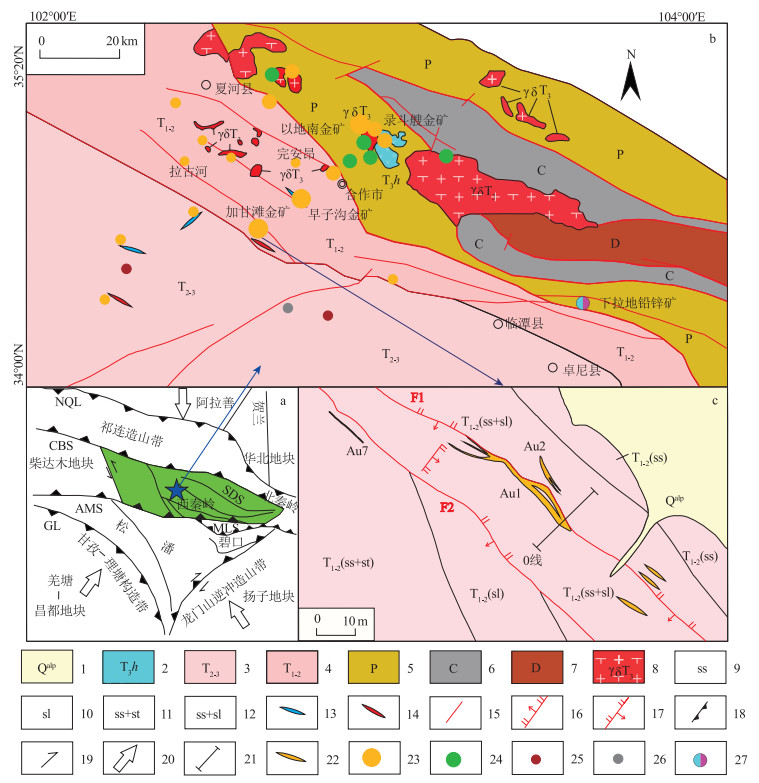
 下载:
下载:
